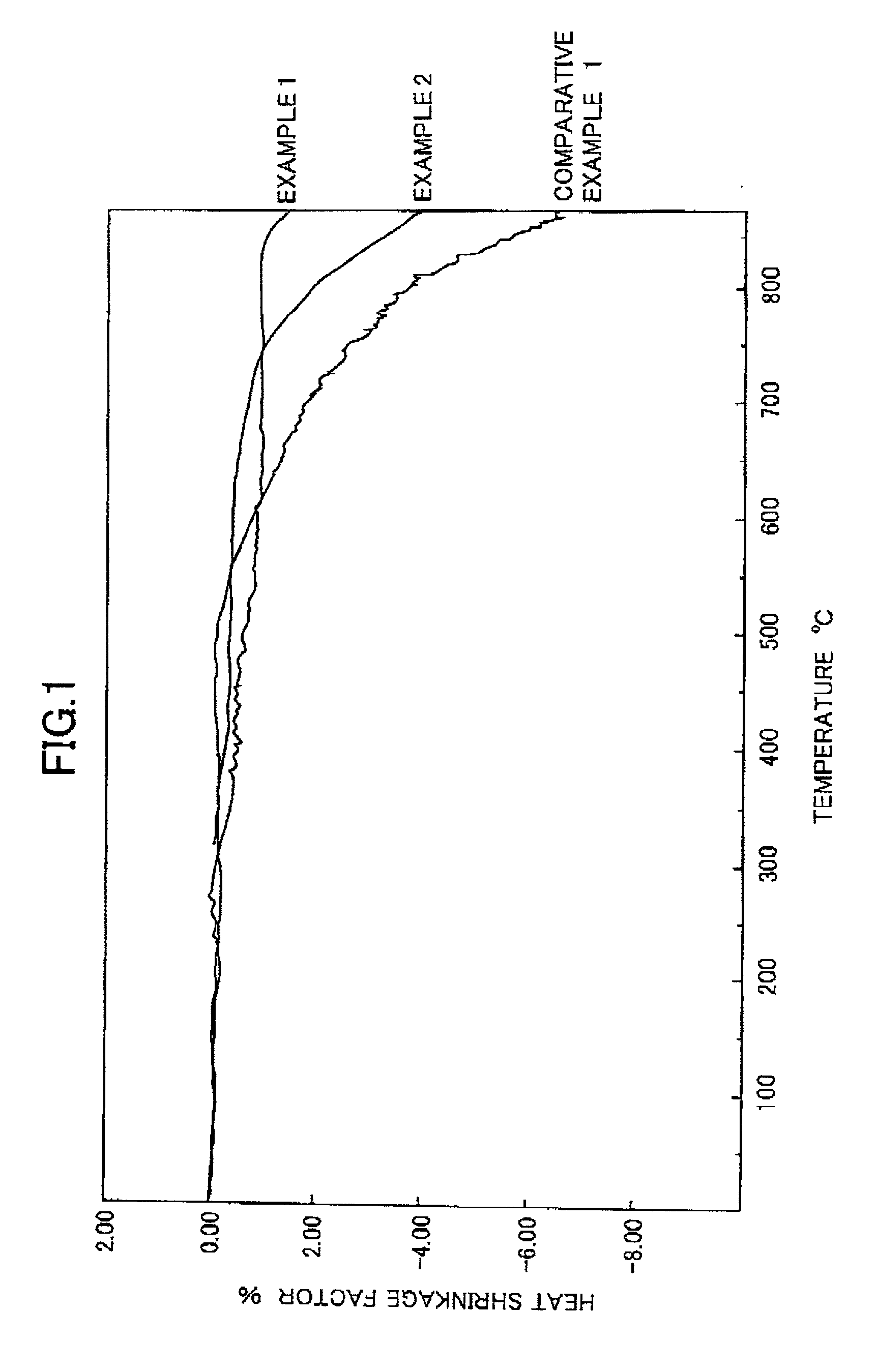Paste to be fired for forming circuit board and method for preparing surface-modified silver powder
a technology of surface-modified silver powder and circuit board, which is applied in the direction of manufacturing tools, solventing apparatus, transportation and packaging, etc., can solve the problems of deterioration of the electrical characteristics of the resulting wiring, low heat shrinkage,
- Summary
- Abstract
- Description
- Claims
- Application Information
AI Technical Summary
Benefits of technology
Problems solved by technology
Method used
Image
Examples
example 1
[0035] To 100 parts by mass of silver powder (having an average particle size of about 0.5 .mu.m as determined by the SEM observation), there was added 5 parts by mass of aluminum oxide (having an averaged primary particle size of about 15 mm and a specific surface area of about 100 m.sup.2 / g), followed by sufficient stirring Thus, there was prepared metal silver particles in which fine particulate aluminum oxide was adhered to the surface of the silver particles. Then the silver particles were introduced into Hybridizer (available from Nara Machinery Co., Ltd.) and circulated in the device at a rate of 8000 rpm for 5 minutes to thus give surface-modified silver powder in which fine particulate aluminum oxide was adhered to the surface of the metal silver particles. The fine particulate aluminum oxide was not released from the metal silver particles at all even if the surface-modified silver powder was dispersed in a solvent.
[0036] A pressure of 98 MPa was applied to 0.5 g of the su...
example 2
[0037] The same procedures used in Example 1 were repeated except that fine particulate silicon oxide (having an average primary particle size of about 7 nm and a specific surface area of about 300 m.sup.2 / g) was substituted for the fine particulate aluminum oxide used in Example 1 to give surface-modified silver powder in which the fine particulate silicon oxide was adhered to the surface of the metal silver particles.
[0038] A pressure of 98 MPa was applied to 0.5 g of the surface-modified silver powder to thus mold the powder into a pellet having a diameter of 5 mm and a height of about 5 mm. This pellet was heated to 900.degree.C. using the same device and conditions as in Example 1 to determine the heat shrinkage factor. The results obtained are shown in FIG. 1, while taking the thickness of a green compact prior to heating as a standard. As will be seen from the data shown in FIG. 1, the heat shrinkage factor was found to be only about 3%, even at a high temperature of 850.degr...
example 3
[0039] To 4 liters of pure water in a stainless beaker, there was added 60 g of silver powder (having an average particle size of about 1 (m as determined by the SEM observation), followed by sufficiently stirring to give a slurry, heating the slurry to 60.degree.C. and maintaining the slurry at that temperature. To the slurry, there was added, at a time, an aqueous solution preliminarily prepared by dissolving 17 g of sodium silicate solution (including 35 to 38% of SiO.sub.2, a product of Kanto Kagaku) in 50 ml of pure water and the mixture was sufficiently stirred. Then, the mixture was neutralized with a solution of 18.5 g of concentrated sulfuric acid in 50 mL of pure water and stirred for one hour. Thereafter, the mixture was filtered through a Buchner funnel and fully dried to obtain a cake, which was then dried at 70.degree. C. for 5 hours in a hot air drier. After drying, the cake was passed through a vibrating sieve (200-mesh) to obtain surface-modified silver powder in wh...
PUM
| Property | Measurement | Unit |
|---|---|---|
| particle size | aaaaa | aaaaa |
| atomic number | aaaaa | aaaaa |
| particle size | aaaaa | aaaaa |
Abstract
Description
Claims
Application Information
 Login to View More
Login to View More - R&D
- Intellectual Property
- Life Sciences
- Materials
- Tech Scout
- Unparalleled Data Quality
- Higher Quality Content
- 60% Fewer Hallucinations
Browse by: Latest US Patents, China's latest patents, Technical Efficacy Thesaurus, Application Domain, Technology Topic, Popular Technical Reports.
© 2025 PatSnap. All rights reserved.Legal|Privacy policy|Modern Slavery Act Transparency Statement|Sitemap|About US| Contact US: help@patsnap.com

